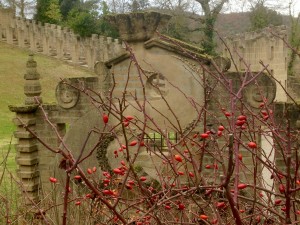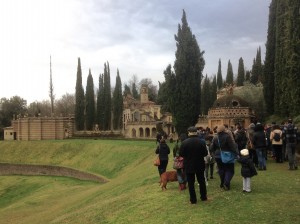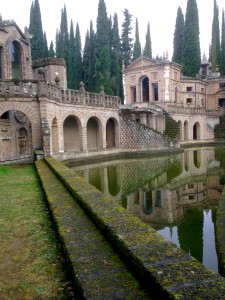Today, thanks to my friends Andrea and Natsuko, I left the confines of the rock upon which rests Orvieto. I actually climbed into an automobile. Emelio the anthropologist drove. We went north on the autostrada to the Fabro exit, then took back roads to Montegabbione.
Emelio is thirty-three and an Orvietano from birth. Andrea has lived in Orvieto since the nineties, and had worked here before that. That’s the setup.
“What’s that town over there?” I ask. Um. Silence. Um. Andrea? I don’t know. Maybe Monterubiaglio? No too large. Fabro? No, we went through Fabro already. Maybe it’s… silence. Panicale? No, that’s much further north. Well, everyone, we’re going to be really early if we go straight to La Scarzuola from here, how about we stop at a bar for a bite to eat? All agree that is a good idea. What about Montegiove, do they have a good bar? I don’t know. Okay, let’s try. Where is it? The sign says left. (We arrive.) Nothing here at all. How about Montegabbione? (Back in the car.) Hey, I don’t see anything. I’ll get out and ask. Okay. (Andrea returns.) The only bar in town is over there. It’s Eva’s Bar. (Eva is charming, sweet, and very slow.) Do we have time? Probably not. Okay, let’s go on to La Scarzuola. I brought bananas. “Thank god! I’m hungry.”
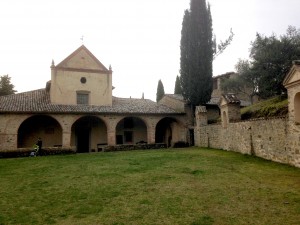 Wending our way towards La Scarzuola was familiar and comfortable. Like traveling here with anyone else I’ve ever traveled with here – normally Americans, all of us perpetually lost. I’m about as savvy with the countryside in Northeastern Pennsylvania, so I don’t complain. We ate fruit. We found our destination. And we arrived on time. Very important according to Emilio. The guy who runs the place is a little weird – two minutes late, you don’t get in.
Wending our way towards La Scarzuola was familiar and comfortable. Like traveling here with anyone else I’ve ever traveled with here – normally Americans, all of us perpetually lost. I’m about as savvy with the countryside in Northeastern Pennsylvania, so I don’t complain. We ate fruit. We found our destination. And we arrived on time. Very important according to Emilio. The guy who runs the place is a little weird – two minutes late, you don’t get in.
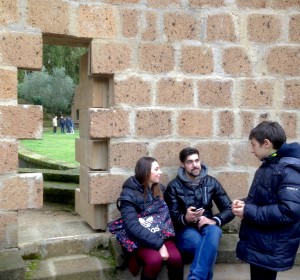 Saint Francis lived here here in 1218. He built a hut out of a brush called scarza, so the site became known as La Scarzuola. He also planted a rose bush that opened up a miraculous spring. Thereafter the Counts of Marsciano erected a church and founded a convent on the site. Then in December 1956 the complex was purchased by Tomaso Buzzi from Milan, a famous architect. He restored the convent and church, and drew up plans for what he called The Ideal City — la Città Ideale. It is neo-mannerist in form, scenographic, deliberately theatrical, a stylistic composite of classical, medieval, renaissance, baroque, and a touch of 1950’s surrealism mixed in with inspirational guidance from Prince Orsini’s Sacro Bosco in Bomarzo. Construction continued from 1958 to 1978. Buzzi died in 1981, the project incomplete.
Saint Francis lived here here in 1218. He built a hut out of a brush called scarza, so the site became known as La Scarzuola. He also planted a rose bush that opened up a miraculous spring. Thereafter the Counts of Marsciano erected a church and founded a convent on the site. Then in December 1956 the complex was purchased by Tomaso Buzzi from Milan, a famous architect. He restored the convent and church, and drew up plans for what he called The Ideal City — la Città Ideale. It is neo-mannerist in form, scenographic, deliberately theatrical, a stylistic composite of classical, medieval, renaissance, baroque, and a touch of 1950’s surrealism mixed in with inspirational guidance from Prince Orsini’s Sacro Bosco in Bomarzo. Construction continued from 1958 to 1978. Buzzi died in 1981, the project incomplete.
The only member of his family who had an interest in the property, or perhaps who had nothing else to do, was Buzzi’s nephew, Marco Solari. He finished realizing his uncle’s dream. Not himself personally, mind you, the family has money, but he oversaw the completion of the project. What resulted is not easily described. That is why pictures were invented.
The nephew still owns the property. He lives there with his boyfriend. It’s their home. One imagines that living on such a property might create some strange habits of mind. One only has to listen to Marco Solari for a few minutes to realize it has done exactly that. The man is funny. He is quirky. He guides the tour, speaking easily in a trumpet voice that could carry over a pitched battle. He poses a question, hovers a moment, answers it himself, then laughs a laugh that could be described as a gay, Italian, male version of Phyllis Diller. Then he holds forth and repeats the cycle. I don’t imagine he would be an easy person to have dinner with.


His partner was speaking with guests on our way out. They asked if tours were given in English. Yes, he said, I do them. They are nothing like that, he said, pointing towards Marco.
 This is all correct and as it should be. Two men with opposite styles. One of them, at least, generously quirky. No one more suited could possibly be associated with the place, to live there, lead guests through the property, or to have completed Buzzi’s work. Some day they will turn it over to a foundation or a comune. The experience may then become more conventional, but it won’t be as rich, as flavorful, or as much of a piece.
This is all correct and as it should be. Two men with opposite styles. One of them, at least, generously quirky. No one more suited could possibly be associated with the place, to live there, lead guests through the property, or to have completed Buzzi’s work. Some day they will turn it over to a foundation or a comune. The experience may then become more conventional, but it won’t be as rich, as flavorful, or as much of a piece.
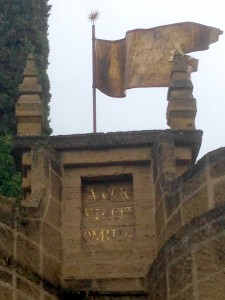 Buzzi described the project as his inner life in stone. To paraphrase; I’m conventional in my business. I design buildings people like. I do my job. But inside, another spirit stirs. The Ideal City is an expression of my true personality, the one that is hidden, secret, unknown in my other work.
Buzzi described the project as his inner life in stone. To paraphrase; I’m conventional in my business. I design buildings people like. I do my job. But inside, another spirit stirs. The Ideal City is an expression of my true personality, the one that is hidden, secret, unknown in my other work.
The Ideal City seems at first glance to be an architectural installation with no purpose but to be beautiful, bizarre, and evocative. Not quite true. The literature says there are seven theatres on the property. Counting smaller, non-traditional spaces, I found five of them. Andrea and I went around staging Shakespeare’s plays in those spaces we could identify. Almost any classic or epic play could have a happy home somewhere among the sculptural tangle. Rumor is that concerts are offered at La Scarzuola from time to time, but because the website is either under construction or will never be complete, that’s difficult to verify. It would be grand to hear music in these environs.
Our group filters out after about two hours, and we hop back into the car to wind our way home. A beautiful town appears on the hill ahead of us. “What’s that town?” Silence. Time. We pass a blue-arrowed sign pointing up the hill. The sign says, Carnaiola. That’s Carnaiola, Emilio tells me. “Thank you.”

